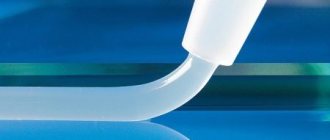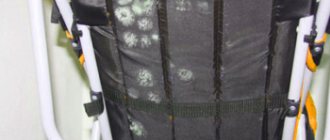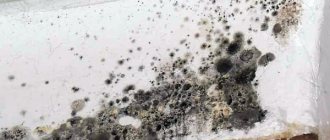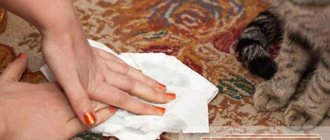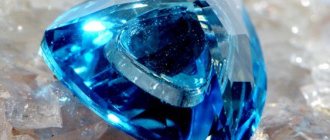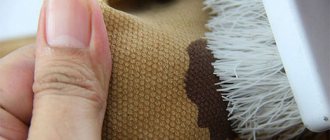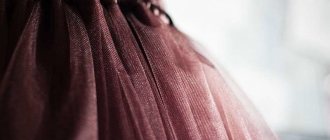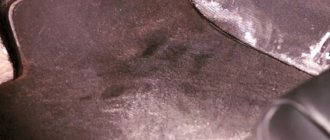Molds have long been used by people to make sherry and special types of cheese. Mold is used to produce citric acid and many antibiotics. Unfortunately, in addition to such beneficial molds, there are other, harmful varieties of this microscopic fungus that settle on the walls of houses and begin to actively destroy them. In addition to damaging the walls, house mold has a negative impact on the health of the inhabitants of the home and causes an unpleasant odor in the premises. To successfully fight such an insidious enemy as mold, it is necessary to reliably determine the type of parasite and find out the reason for its appearance.
General concept of mold fungus
I want to tell you what happened to me recently. I was away for a couple of months, and when I returned home, I smelled mold. And so it turned out - a black spot was found on the wall. I immediately called my neighbor because she had already had such an unpleasant experience. She told me how to remove mold from the wall in the apartment.
1.1 Mold. What is it and why does it start on the wall?
Let me start with the fact that mold is everywhere - in the soil, on trees, in the air. Its spores were found at an altitude of 80 km from the ground. It is an extremely tenacious fungus with long branching filaments (hyphae) in gray, black, green or white. The most favorable climate for it is a warm, humid place with poor air access.
One damp corner is enough to make you wonder how to remove mold from your apartment.
1.2 Reasons why fungus starts
Mold can appear in an apartment for the following reasons:
- Humidity 65% or higher. Sources may include leaks, poor ventilation in the kitchen, frequent drying of damp laundry, frequent and abundant spraying of flowers;
- Poor ventilation throughout the house. Stagnant air increases humidity and creates comfortable conditions for fungus;
- Uneven heating of walls. Especially in the fall, when heat has not yet reached the apartments and dampness is present everywhere: on the street, in the apartment.
- There is little benefit from rapid temperature changes. For example, when you are independent of central heating and have your own boiler, you should not get carried away with changing modes, or even turn off the heating altogether when leaving the house.
- The home gets cold and the same condensation forms under the ceiling due to the difference in climate inside and outside.
Favorite places for mold in the apartment are the bathroom, corners, plastic windows, kitchen ceiling, tiles
.In private houses, you can add a cellar, wooden floors, and walls to this list. Mold also takes root well on concrete, plaster, linoleum, carpets, window frames and in washing machine drums.
1.3 How to usually remove mold yourself
You can fight the pest yourself. Before handling, be sure to wear goggles, gloves and a mask.
Spores entering the respiratory tract or mucous membranes can cause allergies, cough, conjunctivitis, so you should protect yourself.
Also be sure to open the windows and allow fresh air to flow.
Step 1: Make a bleach solution in a ratio of 1 part bleach powder or bleach to 3 parts water. Step 2. Take a brush with elastic bristles, rub the areas darkened by plaque, remove the growths. Step 3. Rinse well with water and wait until completely dry.
1.4 What to do to prevent mold
Once you have gotten rid of the mold, ongoing preventative maintenance is a must. Important: use at least 2 permanent methods. This will double your chance of success, as mold spores can remain inside walls for a long time.
What can be done for prevention?
— Check the serviceability of the ventilation system in the apartment, arrange ventilation; — Carry out regular cleaning of “problem areas” with soda or alcohol solution; — Make sure that the bathroom and kitchen are as dry as possible; — Carefully dry things, towels and curtains in the bathroom so as not to create dampness; — Replace pipes and other leaking plumbing fixtures in a timely manner; — Buy special anti-fungal paint.
Tip: Consider installing an electric dehumidifier. It will relieve problems with dampness for a long time.
Don't be afraid of the fungus reappearing. You can handle it.
Know the enemy by sight
Often people live in an apartment affected by fungus and do not realize the seriousness of this problem. To clearly understand the situation, be able to recognize mold that is harmful to health.
We recommend reading - Forewarned is forearmed! Which mold is the most dangerous?
Types of mold dangerous to the body:
- White - this type of fungus is common in flowerpots, the reason is excess moisture or fertilizer that feeds the fungal environment. Allergic reactions in the human body are possible.
- Green - often occurs on food products, mainly on bakery products. Less commonly, this type of mold appears on brickwork. If ingested through food, it can cause diarrhea.
- Black - this type is perhaps the most common and dangerous. It can attack many surfaces: concrete, plaster, paint, wallpaper, wood, etc. If you remain under its influence for a long time, then, as a result, insomnia, dizziness, increased body temperature, migraine may appear, and more severe diseases may develop: bronchitis, asthma, pneumonia, skin diseases.
- Bluish - its manifestations are mostly found on wooden surfaces: window frames, natural parquet, furniture. Such mold can destroy even a layer of paint or varnish.
- Actinomycetes (in common parlance, radiant fungi) also love wood. Under their influence, the tree changes its natural color to a gray or brown tint, loses density, and is riddled with cracks.
If there are unexplained signs of cough, rhinitis, shortness of breath, this is an alarming call about the presence of mold in the apartment. Flying fungal spores can also cause nausea, vomiting, and chronic fatigue. In addition to the spoiled appearance, the fungus destroys building materials, affecting more and more new areas. Therefore, we must not hesitate, and even at the slightest manifestation of a problem, we remove the mold.
Stages of mold control
Before joining the fight, think about why mold has grown in this place and eliminate the root causes. This may be due to lack of ventilation, tightness of double-glazed windows, or, conversely, cracks in the wall.
2.1 Determine the sequence of steps
The general way to remove mold on the walls in an apartment will be like this:
- — Analyze the scale of fungal infection;
- - Look at the appearance of the surface. The processing method will depend on this;
- - Choose the appropriate remedy. Remember to protect your hands and airways so that particles do not get into them while you scrape or scrub the growth;
- - Try to throw away everything that can be thrown away after work - get rid of the fungus breeding ground;
- — Follow preventative measures: ventilate, wash the walls, wipe the tiles dry, keep warm.
If it is not possible to remove mold from the wall in an apartment using home methods, they resort to the services of agencies dealing with this issue.
2.2 Removing fungus and mold
Let's say you notice a small stain and rush to clean it up. This will not stop there.
Just cleaning will not work to remove mold from the wallpaper in the apartment - the old covering will have to be removed.
And often the plaster underneath. Fungal spores penetrate deep into the wall and can grow again later.
Simply gluing new wallpaper will not help.
Arm yourself with gloves, a respiratory mask, a spatula, a sponge, hard sandpaper and an antiseptic solution. First, peel off the paper completely. Scrape off the plaque along with the blackened pieces of plaster.
Tip: To prevent microparticles from flying around the room, moisten the wall.
Sand the affected areas well with sandpaper. After this, saturate the wall with an antibacterial agent (chemical, folk) to remove mold from the wall in the apartment. The surface treatment should be repeated 4-5 times, the walls should be thoroughly dried, primed, re-plastered and only then wallpaper should be glued.
To prevent mold from growing again in the future, arrange frequent (through) ventilation.
It is undesirable to place furniture close to damp walls - this causes the appearance of fungus and a musty smell.
Hint: The lack of air may be caused by an over-tight window.
Take care of this: open the vents and windows, install a ventilation valve. Errors during sewer installation or repairs also provoke the formation of mold under the wallpaper.
Reviews
Users note that all the drugs coped well with the problem of fungus in the bathroom. Here's what they say about Haiter spray foam for mold removal:
- No matter what means I used to remove black mold in the bathroom between the tiles at the seams: soda, citric acid, and even ordinary bleach - nothing helped. In a Japanese cosmetics store I came across the Haiter spray foam (380 rubles). It’s very convenient to use. After just 10 minutes, the mold began to disappear right before our eyes. One drawback is that you can’t actually find spray foams on sale. Marina
- I always bought Savo, and then switched to Astonish. The price is lower, but the effect is the same. Those who have chosen the drug Savo, be sure to buy the Polish one. Only he helps. Kate.
Please note that most mold and mildew products contain chlorine, so be sure to take precautions when using these products.
How to get rid of fungus on the wall
The appearance of mold stains on the walls can be caused by their freezing, internal leakage of pipes, or damp building materials. The lack of protective canopies from rain and gutters also creates conditions for the accumulation of moisture in the walls and the establishment of fungus.
3.1 What is the harm from mold?
The accompanying problems caused by the appearance of mold concern not only the destruction of the home, but also affect health. If the immune system is weakened and does not resist infections well, then microspores of the fungus can cause allergies, cough, and breathing problems. Once in the lungs, they cause bronchitis, rhinitis, and asthma. The skin is manifested by dermatitis, psoriasis, eczema, itching and other ailments. Small particles of mold enter the stomach along with food, and cause stomach pain, nausea, and poisoning. Carefully!
Black mold often contains toxins that are harmful to the body. With constant accumulation, the kidneys are affected.
In addition, it spoils the appearance of the home, destroys walls, plumbing, and furniture.
3.2 Removing mold from the wall
Inspect the surface you will be working on. It happens that the fungus has “eaten” most of the wall and it needs to be dismantled. Wooden coverings are more often susceptible to this. If the outbreak is small and can be removed, then “fighting” is necessary. I will share the tips I received on how to remove mold from the wall of an apartment using folk remedies.
Copper sulfate helped me defeat fungus and black mold.
In Soviet times, this product was used to disinfect premises, and today it is successfully used to protect walls from mold deposits. Only 10 grams of powder is enough per liter of water.
Don't forget that vitriol is poisonous - wear rubber gloves and cover your face!
Just as in the case of wallpaper, it is better to moisten the walls so that the spores do not fly away and settle on other surfaces. Using a spatula or blunt knife, separate the growths from the wall. Spray the prepared solution on the infected areas or wet them with a sponge. Repeat the process 3 times during the day after each wall has dried. The final time, thoroughly wash everything with water and ventilate the apartment. It is recommended to treat the equipment with an antiseptic or throw it away.
Tip: a powerful hair dryer will help speed up the drying process.
You can buy vitriol in hardware stores; you need to use warm water - this way the sulfate dissolves faster. A spoon of vinegar will help make the product more powerful.
Monarda oil stops the growth of fungus, and tea tree oil copes with the first manifestations of plaque. Take 2 ml of oil, 1 tsp of coarse salt and 100 ml of water. Apply to the mold stain and leave. There is no need to rinse off the product.
3.3 Preventing reappearance
Look at the source of the congestion. If it is only in a certain place (under the sink, in the far corner), then the problem is poor ventilation; this area remains damp longer. Provide good ventilation and treat surfaces until the mold and odor disappear.
Think about why the mold appeared here.
You may need to adjust the heating, insulate the walls or improve the ventilation. Don't forget to fix leaks, cracks and crevices in window frames.
What is the danger
Dampness on the walls and dirty stains spoil the appearance of the room and damage the repairs made. However, this is not the only and not the main reason for which decisive countermeasures should be taken.
The fungus is dangerous and toxic to the human body.
First of all, when staying in such conditions for a long time, the respiratory tract suffers. Depending on how badly the walls and ceiling are affected, you may experience coughing and difficulty breathing. Symptoms of poisoning such as nausea, vomiting, and dizziness may appear.
Mold has a particularly strong and harmful effect on children’s bodies.
Therefore, it is necessary to fight it, control the humidity in the house and prevent the spread of spores through hidden cavities.
Five effective remedies against mold
It happens that the ventilation works as it should, there is no freezing, the apartment does not smell damp, but the fungus still appears. Most likely, this is a leak in the water pipes embedded in the wall. Only masters help here. And you can handle other cases yourself. To remove mold from the wall in an apartment using home remedies, we will need patience, perseverance and a couple of simple products:
4.1 Table vinegar
Wipe well or spray the wall with vinegar from a spray bottle, leave for a while, then wash thoroughly with water and make sure everything is dry. This is very important not only because of the vinegar smell: this way you will not create dampness;
4.2 Hydrogen peroxide
A familiar antibacterial agent. To remove mold from a wall in an apartment, you need to treat it with a 3% hydrogen peroxide solution. Peroxide copes well with bacteria, but once will not be enough - the procedure must be repeated until the stain completely disappears;
4.3 Soda
Kills the favorable environment for fungal growth. It is safe and does not have such a pronounced odor as vinegar. For the desired effect, 1 tablespoon per glass of water will be enough. An additional advantage of soda is that it is non-toxic and does not need to be re-treated with water;
4.4 Ammonia
Will help cope with mold on tiles, plastic, glass. It is diluted with water 1:1 and applied with a sponge, brush or microfiber cloth so as not to scratch the surface.
Don't forget to wear gloves so that the alcohol doesn't dry out your hands;
4.5 Bleach
Any one that you are used to using for laundry. This is more “heavy artillery”, less natural, but very effective (due to the alkali in the composition) for hard-to-reach places - far corners, pipes, baseboards. Dilute 1 capful of product in 500 ml of water and spray on the wall or tiles. After removing the fungus, thoroughly clean the entire room;
Remember: chlorine, peroxide and ammonia have bleaching properties.
Take this into account when processing different surfaces.
Causes of mold
- The breeding ground for fungus is a room with high humidity. But this does not mean that dampness should reign in the house. One damp corner is enough to cause mold to appear. Humidity above 65% is considered high.
- The reason for excess humidity is freezing of walls and windows.
- Temperature differences are a fertile environment for the formation of condensation.
- The next important factor is insufficient ventilation. For this reason, moisture stagnation occurs.
- Another reason is hypothermia in certain areas of the room.
To effectively remove mold, eliminate these problems first.
How to get rid of black
Of the 200 types of mold that exist, 20 grow in homes.
It spreads very quickly throughout the apartment and is harmful to health. Therefore, you need to clean it off in full camouflage - a mask, gloves and closed clothing.
Green is the most common. This species is quite harmless and easy to deal with.
Dark green growths will require more effort, but are also not problematic. But black mold often contains toxic substances and can harm health and immunity. There is also a lot of hassle in the fight against it - strong drugs and frequent treatment will be required.
5.1 Why does black mold appear?
How to remove black mold in an apartment - the most tenacious and dangerous?
It will not be possible to completely get rid of the fungus unless the reasons for its appearance are identified: - Windows with increased tightness. The design prevents fresh air from entering the room; — The apartment is located on the first or last floor. The basement may flood, the roof may leak. All this serves as a source of dampness, which the fungus loves; — Residual moisture after repair. Do not open the windows, wait until the wallpaper is completely dry; — Poor ventilation in the bathroom. Where it is both humid and warm. The fungus is a real haven here; — Flowers on the windowsill.
Frequent spraying and watering add moisture to the home.
Additional reasons for the accumulation of moisture may be drying clothes, neighbors flooding from above, or rotten internal pipes.
5.2 Removing black mold on your own
Be prepared for the fact that one procedure will not do. Spores can “sit” inside walls for years, each time appearing on the surface under comfortable conditions. If a fungal colony has formed on the tiles in the bathroom, then it is easier to deal with it. Wash, clean and dry the tiles. Treat with soda or alcohol solution.
Don't forget about the seams between the tiles!
An old toothbrush will help you get there. Check ventilation and ensure wet areas in the bathroom are completely dry. And if black specks are visible on the walls, you will have to tinker. Table vinegar will help in treating mold. Apply the product generously to the infected area and leave for an hour. Just in case, spraying can be repeated again. After completing the work, wipe all surfaces with water and ventilate the apartment.
Ordinary “Whiteness” will also be a powerful assistant in this matter.
.Wall finishing does not affect the appearance of fungus in any way; it will take root well on both wallpaper and drywall. But cleaning, ventilation and cleanliness reduce the viability of spores.
5.3 What to do to prevent black mold from coming back again
In order not to be afraid of the regular appearance of black fungus in your home, you should follow a number of simple rules: - Set up a ventilation system in the bathroom and kitchen; — When cooking, turn on the hood or open the window. Hot steam accumulates under the ceiling, on the wallpaper and can cause mold to form; — Monitor the condition of plastic windows, adjust them for the winter; — Do not get carried away with frequent spraying of flowers indoors; — Fix leaks in a timely manner.
Methods for eliminating unpleasant odors
To eliminate the unpleasant odor emanating from black mold, you will first need to identify the source of its spread. If floor tiles, parquet or plasterboard areas on the walls are damaged, it is recommended to replace them with new material.
If the eaten surface cannot be replaced, you can use a mixture containing the following ingredients:
Mold repellents: soda, sodium, vinegar, citric acid.
- boric acid;
- hydrogen peroxide;
- white vinegar;
- running water.
All ingredients are mixed in the following proportions: for 1 part boric acid there is twice the amount of peroxide and vinegar, as well as four times the amount of water.
This mixture eliminates both the original source and its consequences. Before applying it, it is necessary to clean the surface of the walls. After treating the affected areas, you need to ventilate the room well and let it dry.
The smell of black mold can be eliminated with regular baking soda. It needs to be sprinkled on the eaten areas of the walls and left for a certain time. As soon as the smell disappears, thoroughly clean the treated coating with a vacuum cleaner.
Mold in the apartment on different surfaces
6.1 How to remove mold from the ceiling in an apartment?
The appearance of plaque in such a place indicates leaking pipes or roofs, poor evaporation of moisture due to lack of air. Try rinsing the small fireplace well with laundry soap and drying it. But if the fungus has already grown, it is too late to do prevention. Corrective measures are needed. Put on a mask and goggles, wash off the whitewash, and remove the paint and plaster from the ceiling using a spatula. Soak the corners and surface with an antiseptic primer (this is convenient to do with a wide brush). When the primer is dry, apply a layer of putty. Prime again and dry.
Tip: Concrete and brick dry faster if you turn on a gas burner.
A wood ceiling will benefit from a heater or fan. The last step will be painting.
A secret that will benefit your budget: instead of an antiseptic, you can use ordinary “Whiteness”.
Simply painting a moldy ceiling will not solve the problem. The paint will kill the fungus on the outside, but not on the inside. And after a while he will appear again.
6.2 What to do if mold has grown in the corners
Before you remove mold in the corners of the apartment, look at which corner it appeared in. If the corner is formed by an external wall, it is necessary to insulate the home from the outside and seal the cracks under the windows. Regular rain can also be a cause. If the house does not have gutters and canopies, it makes the wall damp, and dampness is a good conductor of mold into the house.
Mold is always a result, not a cause.
An alcohol solution or vinegar will help remove fungus from a corner. After impregnation, the corner must be dried thoroughly and a layer of fresh putty must be applied.
Hint: treat not only the infected area, but also the entire wall so that small particles do not “transplant” to another place
.It is better to carry out work in warm, dry weather.
6.3 Removing fungus from a wooden floor
Remove the top moldy layer of wood using a metal scraper or knife. Then sand the surface with stiff sandpaper. Prepare 2 or 3 antifungal agents and apply to the floor in turn after each drying.
If the area is large, repeat the treatment 7-10 times. After this, the floor can be covered with drying oil against parasites and painted.
6.4 Getting rid of white mold on the carpet
If it is possible to treat the carpet outside, do so so as not to spread harmful spores around the room during cleaning. If not, try covering the furniture. Turn on a bright light to ensure you don't miss a particularly tricky spot of mold. Use a firm brush to remove build-up from both sides of the carpet. Saturate the surface with an antiseptic.
I recommend peroxide: it does not “burn out” the color and does not leave a smell.
Dry and roll up the carpet and treat the floor. (2 – 3 times). Also remember to disinfect all tools. Try to warm and ventilate the area well for a week to get rid of any spores remaining in the air.
6.5 How to remove fungus from drywall yourself
All that remains is to find out how to remove mold from drywall.
Causes of mold on drywall include water leaks (you've been flooded), faulty ventilation, or leaking pipes.
Cleaning with a metal spatula, impregnation with an antiseptic solution, priming and painting will help deal with small spots. And if the mold is large and shaggy, then the sheet of drywall cannot be completely cleaned - it is better to replace it.
Varieties
In order for your efforts to be effective and have a lasting effect, it is important to understand that there are different types of flowers. They can be distinguished visually by color and depending on the location. The fungus affects different materials differently. There are several types:
- white mycelium, as a rule, develops and multiplies on the ground in pots of plants if they are over-watered (but should not be confused with salt deposits);
- green marks are characteristic of food when the process of decay begins;
- The most dangerous and harmful is considered to be black mold, which affects the surfaces of walls, ceilings, stains boards, paint, wallpaper, and forms in hidden cavities;
- bluish or pink rot manifests itself as stains on furniture and wooden interior items, leading to rot and destruction.
Knowing how dangerous such deposits are on any surfaces of the house, you need to make every effort to get rid of it and clean the room. Ignoring the problem and staying in conditions of increased dampness for a long time can even lead to pneumonia, bronchial asthma or the development of tuberculosis. Therefore, it is important to find radical and effective methods to solve it.
How and why to deal with mold odor
Removing a musty smell can be more difficult than the fungus itself. It quickly eats into walls, furniture, things and harms not only the house, but also the well-being of the residents. The smell has a particularly negative effect on children and the elderly.
How to remove the smell of mold in an apartment?
There are two options: to prevent the appearance or to fight an already existing fungus. In both cases, inspect the home and determine the source of the odor. Then dry the premises. Spraying a solution with tea tree oil, vinegar, or wiping surfaces with a soda solution will help quickly overcome the unpleasant aroma. For preventive purposes, you can use an aroma lamp with any citrus oils.
Why does mold appear?
Mold begins to multiply when it gets into the right environment.
- Humidity. The ideal level is 60–80%. There may be so much moisture in the bathroom or shower room if your neighbors recently flooded you or if condensation appears on the windows after a change in weather.
- Temperature. Mold survives both very low and high temperatures. The most favorable range is from 4 to 20 °C.
- Ventilation. Closed windows, a pile of furniture, heaps of scattered things - and now it’s difficult for air to circulate around the room, it becomes more and more saturated with mold spores, and it becomes easier for fungus to multiply.
Prevention
Don't forget that dryness is the main enemy of mold.
- Do not close the bathroom door completely so that the room is constantly ventilated.
- Check the ventilation ducts in your bathroom as often as possible to ensure air flow.
- An installed heated towel rail will perfectly cope with high humidity in the bathroom.
- For prevention, periodically treat the seams in the bathroom with vinegar or wipe with bleach.
- If possible, take care in advance to prevent mold from appearing in the bathroom. To do this, be sure to pre-treat the walls with special anti-mold agents during repairs. At a minimum, purchase an antifungal primer.
If no method has worked for you on how to remove mold and mildew in the bathroom, contact the sanitary and epidemiological station. Specialists will determine the type of fungus and take the necessary measures.
